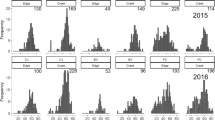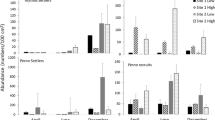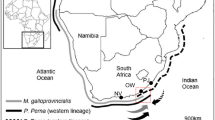Summary
Although mussel beds are common in many intertidal habitats, the ecological significance of the aggregated distribution of mussels has not been examined. The ribbed mussel, Geukensia demissa, is found in dense aggregations on the seaward margin of many salt marshes in New England. Here, we examine the population structure of G. demissa in a New England salt marsh and investigate experimentally the costs and benefits of aggregation.
Size, growth rate, and settlement rates of mussels decrease with increasing tidal height, whereas survivorship and longevity increase with increasing tidal height. Winter ice dislodges mussels from the substratum, resulting in mortality over all size classes, whereas crab predation results in the mortality of smaller mussels. The intensity of each of these mortality agents decreases with increasing tidal height. Effects of intraspecific competition on individual growth and mortality also decrease with increasing tidal height.
At high densities, individual growth rates were reduced, with depression of growth rates most pronounced on smaller individuals. Mortality from sources other than intraspecific crowding, however, was reduced at high mussel densities, including mortality due to winter ice and crab predators. As a result, our data suggest that the mussel population at our study site would be reduced by 90% in only five years and no juveniles would survive through their second year without an aggregated distribution.
Juveniles settle gregariously with or without adults present. The aggregated distribution of settlers and the postsettlement movement of smaller mussels to favorable microhabitats result in size and age class segregation within the population. This probably reduces intraspecific competition for food, while maintaining the survivorship advantages of an aggregated distribution.
Similar content being viewed by others
References
Bayne BL (1976) The biology of mussel larvae. In: BL Bayne (ed) Marine mussels. Cambridge University Press, Cambridge, pp 81–120
Bertness MD (1984) Ribbed mussels and Spartina alterniflora production in a New England salt marsh. Ecology 65:1794–1807
Brousseau DJ (1984) Age and growth rate determinations for the Atlantic ribbed mussel, Geukensia demissa. Estuaries 7:233–241
Connell JH (1961) The influence of interspecific competition and other factors on the distribution of the barnacle Chthamalus stellatus. Ecology 42:710–723
Hardwick-Witman M (1985) Biological consequences of ice rafting in a New England salt marsh community. J Exp Mar Biol Ecol (in press)
Harger JRE (1968) The role of behavioral traits in influencing the distribution of two species of sea mussel, Mytilus edulis and Mytilus californianus. Veliger 11:45–49
Harger JRE (1970) Comparisons among growth characteristics of two species of sea mussel, Mytilus edulis and Mytilus californianus. Veliger 13:44–56
Harger JRE (1972) Competitive coexistence. Maintenance of interacting associations of the sea mussels, Mytilus edulis and Mytilus californianus. Veliger 14:387–410
Jackson JBC (1977) Competition on marine hard substrata: the adaptive significance of solitary and colonial strategies. Amer Nat 111:743–767
Jordan TE, Valiela I (1982) The nitrogen budget of the ribbed mussel, Geukensia demissa, and its significance in energy flow in a New England salt marsh. Limnology and Oceanography 27:75–90
Kuenzler EJ (1961a) Structure and energy flow of a mussel population in a Georgia salt marsh. Limnol Oceanog 6:191–204
Kuenzler EJ (1961b) Phosphorus budget of a mussel population. Limnol Oceanog 6:400–415
Lent CM (1967a) Effects and adaptive significance of air-gaping by the ribbed mussel Modiolus (arcuatula) demissus. Dissertation, University of Delaware 77 pp
Lent CM (1967b) Effect of habitat on growth indices in the ribbed mussel Modiolus demissus. Chesapeak Sci 8:221–227
Lutz RA, Castagna M (1980) Age composition and growth rate of a mussel (Geukensia demissa) population in a Virginia salt marsh. J Molluscan Studies 46:106–115
Menge BA (1976) Organization of the New England rocky intertidal community: role of predation, competition, and environmental heterogeneity. Ecol Monog 46:355–393
Orth RJ (1977) The importance of sediment stability in seagrass communities. In: Coull BC (ed) Ecology of Marine Benthos. University of South Carolina Press, Columbia, pp 281–306
Paine RT (1971) A short-term experimental investigation of resource partitioning in a New Zealand rocky intertidal habitat. Ecology 52:1096–1106
Paine RT (1974) Intertidal community structure: experimental studies on the relationship between a dominant competitor and its principal predator. Oecologia (Berl) 15:93–120
Paine RT, Levin SA (1981) Intertidal landscapes: disturbance and the dynamics of pattern. Ecol Monogr 51:145–178
Paine RT, Suchanek TH (1983) Convergence of ecological processes between independently evolved competitive dominants. Evolution 37:821–831
Peterson CH (1979a) The importance of predation and competition in organizing the intertidal eipfaunal communities of Barnegat Inlet, New Jersey. Oecologia (Berl) 39:1–14
Peterson CH (1979b) Predation, competitive exclusion, and diversity in the soft-sediment benthic communities of estuaries and lagoons. In: RJ Livingston (ed) Ecological processes in coastal and marine systems. Plenum Press, New York, pp 233–264
Pielou EC (1969) An introduction to mathematical ecology. Wiley-Interscience, New York, 286 pp
Ranwell DS (1964) Spartina salt marshes in southern England. II. Rate and seasonal pattern of accretion. J Ecology 52:79–94
Redfield AC (1972) Development of a New England salt marsh. Ecol Monogr 42:201–237
Seed R (1969a) The ecology of Mytilus edulis L. on exposed rocky shores. 1. Breeding and settlement. Oecologia (Berl) 3:277–316
Seed R (1969b) The ecology of Mytilus edulis L. on exposed rocky shores. 2. Growth and morality. Oecologia (Berl) 3:317–350
Seed R (1976) Ecology. In: Bayne BL (ed) Marine mussels, Cambridge University Press, Cambridge, pp 13–66
Seed R (1980) Predator-prey relationships between the mud crab Panopeus herbstii, the blue crab Callinectes sapidus and the Atlantic ribbed mussel Geukensia demissa. Est Coast Mar Sci 11:445–458
Statistical Analysis System (1982) SAS user's guide. SAS Institute, Cary, North Carolina, 494 pp
Stiven AE, Kuenzler EJ (1979) The response of two salt marsh molluscs, Littorina irrorata and Geukensia demissa, to field manipulations of density of Spartina litter. Ecol Monogr 49:151–171
Suchanek TH (1978) The ecology of Mytilus edulis L. in exposed rocky intertidal communities. J Exp Mar Biol Ecol 31:105–120
Suchanek TH (1981). The role of disturbance in the evolution of life history strategies in the intertidal mussels Mytilus edulis and Mytilus californianus. Oecologia (Berl) 50:143–152
Teal JM (1962) Energy flow in the salt marsh ecosystem of Georgia. Ecology 43:614–624
Witman JD (1983) The importance of competition, physical disturbance and mutualism in maintaining the depth zonation of kelp and mussels. Amer Zool 23:1001
Woodin SA (1976) Adult-larval interactions in dense faunal assemblages: patterns of abundance. J Mar Res 34:25–41
Woodin SA (1978) Refuges, disturbance, and community structure: a soft-bottom example. Ecology 59:274–384
Zar JH (1974) Biostatistical analysis. Prentice-Hall, Englewood Cliffs, New Jersey, 620 pp
Author information
Authors and Affiliations
Rights and permissions
About this article
Cite this article
Bertness, M.D., Grosholz, E. Population dynamics of the ribbed mussel, Geukensia demissa: The costs and benefits of an aggregated distribution. Oecologia 67, 192–204 (1985). https://doi.org/10.1007/BF00384283
Received:
Issue Date:
DOI: https://doi.org/10.1007/BF00384283




